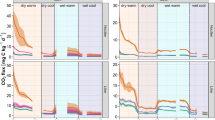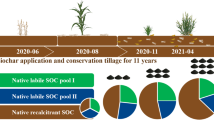Summary
The depth of ploughing has increased in West Germany during the last three decades. Before the 1960s, the depth of the Ap horizon rarely exceeded 25 cm; in the early 1980s it reached about 35 cm on average but it has remained constant since that time. In 1989, the total N content of 105 plots in the southern Niedersachsen loess area was measured after deepening of the plough layers. The N content of the samples was compared with that of earlier samplings (1) before deeper tillage in the 1960s, the 1970s, and the 1980s; and (2) in 1983. Directly after the deeper ploughing, the N content of the topsoil decreased, presumably due to dilution with the subsoil material. Mass balance calculations for total N in 1989 showed that the phase of N accumulation can take 20 years or more. Within two decades, up to 2000 kg N ha-1 was immobilized in the soil organic matter. Recent incubation experiments with disturbed soil indicated that the N mineralization capacity was reestablished in all soils and is now similar to that of the early (1960s and 1970s) and more recent (1980s) deepened plough layers. Undisturbed soil material incubated in plastic tubes showed a significantly reduced net mineralization at water contents above 65% of the waterholding capacity, particularly in the lower part (15–30 cm) of the Ap horizon. This study suggests that N accumulated in the deep plough layers cannot contribute noticeably to net N mineralization in loess soils during the growing season.
Similar content being viewed by others
References
Andres E, Ahl C (1991) Tonmineralogie und Feldspatzusammensetzung in Löß-C-Materialien und deren Auswirking auf den K-Status der Böden. Mitt Dtsch Bodenkd Ges 66:1057–1060
Bach M (1987) Die potentielle Nitratbelastung des Sickerwassers durch die Landwirtschaft in der Bundesrepublik Deutschland. Gött Bodenkd Ber 93:1–186
Bach M, Rode M, Frede HE (1991) Möglichkeiten zur Verminderung des Nitrateintrags in das Grundwasser durch Verringerung des Stickstoff-Überschusses aus der Landwirtschaft. Mitt Dtsch Bodenkd Ges 66:895–898
Balesdent J, Wagner GH, Mariotti A (1988) Soil organic matter turnover in long term field experiments as revealed by carbon-13 natural abundance. Soil Sci Soc Am J 52:118–124
Bonde TA, Christensen BT, Cerri CC (1992) Dynamics of soil organic matter as reflected by natural 13C abundance in particle size fractions of forest and cultivated oxisols. Soil Biol Biochem 24:275–277
Bremner JM, Mulvany CS (1982) Total nitrogen. In: Page AL, Miller RH, Keeney DR (eds) Methods of soil analysis, Part 2, 2nd edn. Agronomy 9, Am Soc Agron, Madison, Wisconsin, pp 595–624
Campbell CA, Paul EA, Rennie DA, McCallum KJ (1967) Factors affecting the accuracy of the carbon-dating method in soil humus studies. Soil Sci 104:81–85
Cannell RQ (1985) Reduced tillage in Northwest Europe — a review. Soil Tillage Res 5:129–177
Christensen BT, Sorensen LH (1986) Nitrogen in particle size fractionations of soils incubated for five years with 15N-ammonium and 14C-hemicellulose. J Soil Sci 37:241–247
Follett RF, Schimel DS (1989) Effect of tillage practices on microbial biomass dynamics. Soil Sci Soc Am J 53:1091–1096
Heinonen R (1962) On the characteristics of topsoils overlying heavy clays. J Sci Agric Soc Finland 34:26–33
Hoffmann A, Richter J (1988) 10 Jahre Nmin-Methode in Südostniedersachsen — Erfolge, Erfahrungen, Grenzen. Kali Briefe (Büntehof) 19:277–296
House GJ, Stinner BR, Crossley DA, Odum EP, Langdale GW (1984) Nitrogen cycling in conventional and no-tillage agroecosystems in the Southern Piedmont. J Soil Water Conserv 39:194–200
Hsieh YP (1992) Pool size and mean age of stable organic carbon in cropland. Soil Sci Soc Am J 56:460–464
Jenkinson DS, Rayner JH (1977) The turnover of soil organic matter in some of the Rothamsted classical experiments. Soil Sci 123:298–305
Lugo AE, Sanchez MJ, Brown S (1986) Land use and organic content of soie subtropical soils. Plant and Soil 96:185–196
Malik KA, Bhatti NA, Kauser F (1979) Effect of salinity on the decomposition and humification of organic matter by some cellulolytic fungi. Mycologia 71:811–820
Nieder R (1990) Die Auswirkungen der Krumenvertiefung auf die Stickstoff-Mineralisation in Löss-Ackerböden. Kali Briefe (Büntehof) 20:197–203
Nieder R, Richter J (1986) C-und N-Festlegung in Böden Südostniedersachsens nach Krumenvertiefung. Z Pflanzenernaehr Bodenkd 149:189–201
Nieder R, Richter J (1991) Langfristige Stickstoff-Immobilisation in südostniedersächsischen Löss-Ackerböden: Entwicklung in den letzten 25 Jahren. Z Kulturtech Landentw 32:248–257
Poier R, Richter J (1991) Einfluß der mechanischen Belastung und Bewirtschaftungsweise auf Regenwurmpopulationen in Acker-Parabraunerden. Mitt Dtsch Bodenkd Ges 66:565–568
Richter J (1982) Gefügeänderungen in intensiv genutzten Lössbödenihre Erfassung, Tendenzen, Bedeutung. Mitt Dtsch Bodenkd Ges 34:173–180
Richter J, Nuske A, Habenicht W, Bauer J (1982) Optimized N mineralization parameters of loess soils from incubation experiments. Plant and Soil 68:379–388
Richter GM, Hoffmann A, Nieder R, Richter J (1989) Nitrogen mineralization in loamy arable soils after increasing the ploughing depth and ploughing grassland. Soil Use Manage 5:169–173
Richter J, Kersebaum KC, Willenbockel I (1991) Gaseous diffusion reflecting soil structure. Z Pflanzenernaehr Bodenkd 154:13–19
Schwerdtfeger G (1979) Die Bedeutung der Bodenbearbeitung für die Veränderung von ackerbaulich genutzten Böden. Mitt Dtsch Bodenkd Ges 29:775–782
Sorensen LH (1975) The influence of clay on the rate of decay of amino acid metabolites synthezised in soils during decomposition of cellulose. Soil Biol Biochem 7:171–177
Stanford G, Smith SJ (1972) Nitrogen mineralization potentials of soils. Soil Sci Soc Am Proc 36:465–472
Tiessen H, Stewart JWB (1983) Particle fractions and their use in studies of soil organic matter: II. Cultivation effects on organic matter composition in size fractions. Soil Sci Soc Am J 47:509–514
Wang TSC, Li SW (1977) Clay minerals as heterogeneous catalysts in preparation of model humic substances. Z Pflanzenernaehr Bodenkd 140:669–676
Author information
Authors and Affiliations
Rights and permissions
About this article
Cite this article
Nieder, R., Scheithauer, U. & Richter, J. Dynamics of nitrogen after deeper tillage in arable loess soils of West Germany. Biol Fertil Soils 16, 45–51 (1993). https://doi.org/10.1007/BF00336514
Received:
Issue Date:
DOI: https://doi.org/10.1007/BF00336514




